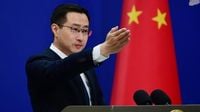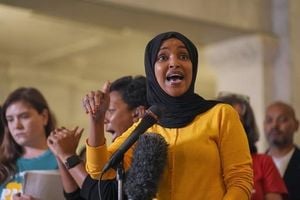For decades, the United States has maintained a complex and sometimes fraught relationship with Latin America, balancing economic interests, security concerns, and diplomatic overtures. But in September 2025, a series of high-stakes decisions and shifting alliances have brought these regional dynamics to the forefront, revealing both the promise and pitfalls of U.S. engagement from Colombia to Central America and beyond.
The latest flashpoint unfolded on September 15, when the Trump administration designated Bogotá as "noncooperative" in the global fight against narcotics. According to Foreign Policy, this annual review marked a sharp escalation in tensions between President Donald Trump and Colombian President Gustavo Petro, whose differing philosophies on drug policy have set them at odds since Trump took office. Trump’s statement, pointed and personal, placed blame squarely on Petro, declaring that Colombia’s failure to meet drug control obligations “rests solely with its political leadership.”
The numbers behind the dispute are stark. In 2023, Colombia’s potential cocaine production soared by 53 percent, the United Nations reported, fueling concerns in Washington about the effectiveness of Bogotá’s anti-narcotics strategy. Petro has openly rejected the punitive approaches of the past, instead championing economic alternatives for coca farmers and seeking negotiated cease-fires with trafficking groups. Intelligence-led operations to dismantle networks have become a hallmark of his administration.
Despite the symbolic blow of decertification, the Trump administration issued a crucial waiver, allowing Colombia to continue receiving U.S. financial support. Without this, U.S. aid would have been slashed and Colombia would have faced obstacles in securing loans from multilateral development banks. As Foreign Policy notes, this is the first time since the 1990s that Colombia was decertified but still granted a waiver—underscoring both the importance and the fragility of the bilateral relationship.
Historically, Colombia has been the largest recipient of U.S. foreign aid in South America, with annual support hovering around $500 million over the past decade. However, a dramatic drawdown of the U.S. Agency for International Development this year means that aid is likely to fall below $100 million in 2025. The exact figure remains elusive, but the trend is clear: U.S. financial backing is waning, even as counternarcotics cooperation remains vital.
Colombian officials, aware of the stakes, traveled to Washington in early September to make their case. Their argument was echoed by U.S. lawmakers, including Representative Gregory Meeks, who wrote to Trump on September 12 that Colombia provides “around 85 percent of the intelligence used by a U.S. task force that interdicts northbound drug shipments” and was responsible for “65 percent of global cocaine seizures in 2024.” For both sides, the message was simple: continued aid is not just a gesture of goodwill, but a linchpin in combating the drug trade that affects the entire hemisphere.
Yet, the current rift is not just about money or even drugs. It touches on Colombia’s broader legacy in peace and security. The 2016 peace deal between then-President Juan Manuel Santos and the Revolutionary Armed Forces of Colombia (FARC) remains a watershed moment. That agreement, which earned Santos the Nobel Peace Prize, saw former guerrillas lay down arms and submit to a special court for crimes committed during decades of conflict. This September, the court issued its first sentences for former FARC fighters—who admitted to mass kidnappings—and, days later, for former government soldiers responsible for killing civilians. Both groups received community service sentences, with prison terms reserved for those rejecting the charges. As Human Rights Watch’s Juanita Goebertus told Caracol Radio, Colombia’s peace process is a “model for the world.”
While Colombia’s struggles with drugs and peace dominate headlines, a quieter but equally consequential transformation is reshaping U.S. relations with Central America and the Dominican Republic. According to a September 19, 2025, report from the Atlantic Council, these countries are fast becoming critical partners in U.S. supply chains—a shift driven by global disruptions, rising tensions with China, and the need for resilient economic links closer to home.
Central America and the Dominican Republic now buy more from the United States than they sell to it, with a staggering 40 percent of U.S. trade flowing through the region via the Panama Canal. The CAFTA-DR free trade agreement underpins this relationship, guaranteeing fair treatment, investment protections, and legal stability. Costa Rica and the Dominican Republic alone supplied 13 percent of U.S. medical device imports in 2023, while Honduras emerged as a top supplier of insulated wire and Dominican free trade zones manufacture crucial electronics components.
Unlike Asian supply chains dominated by Chinese inputs, production in Central America and the Dominican Republic relies heavily on U.S. materials—particularly in textiles, where American yarn and fabrics support more than 400,000 U.S. jobs. This “smiling curve” dynamic, where labor-intensive manufacturing is offshored but higher-value activities remain in the U.S., actually expands American employment and exports, according to the Atlantic Council.
But the strategic importance of the region goes beyond economics. Chinese investments in ports and logistics corridors in Honduras, El Salvador, and Panama have raised alarms in Washington about potential threats to U.S. access to key trade routes. If left unchecked, these projects could undermine U.S. security and influence in the hemisphere.
Policy experts urge action on both sides. The report recommends that Washington expand development finance tools, modernize CAFTA-DR to match the standards of the U.S.-Mexico-Canada Agreement, and establish a regional supply chain security framework. For their part, Central American and Dominican governments are called upon to strengthen the rule of law, improve business environments, and invest in workforce development to meet industry needs.
Meanwhile, trade tensions elsewhere are simmering. In early September, Mexico announced plans for 50 percent tariffs on cars and car parts from countries without a free trade agreement—a move that overwhelmingly targets China, the country’s top car supplier. President Claudia Sheinbaum framed the policy as a boost for Mexico’s own auto industry, but Beijing accused her government of acting “under coercion to constrain China.” As Foreign Policy reports, the Trump administration had encouraged such measures, with U.S. Treasury Secretary Scott Bessent touting the idea of a “Fortress North America.”
Mexico’s gambit is risky. Its auto factories rely on Chinese components, and shifting supply chains will not be easy. Yet, the move signals a broader bet on North American economic integration, even as Mexico seeks to diversify its trade relationships with deals in Europe and talks with Brazil.
All of this unfolds against a backdrop of ongoing diplomatic activity. On September 19, Canadian Prime Minister Mark Carney wrapped up a visit to Mexico City, while European Union foreign-policy chief Kaja Kallas concluded talks in Brazil. The United Nations is also set to weigh in on regional security, with a fact-finding mission on Venezuela scheduled for a press conference on September 22. Meanwhile, Mercosur countries reached a new trade deal with the European Free Trade Association, creating a combined market of 300 million people once ratified.
From the fraught anti-narcotics partnership with Colombia to the evolving supply chain dynamics in Central America and the Dominican Republic, the U.S. faces a pivotal moment in its engagement with Latin America. The choices made now—on aid, trade, and diplomacy—will shape the region’s future and America’s role within it for years to come.




